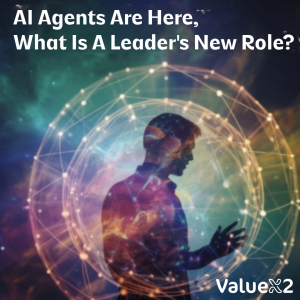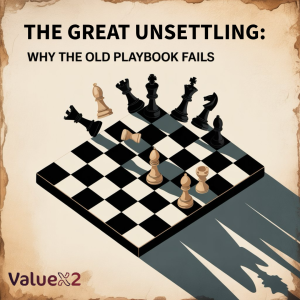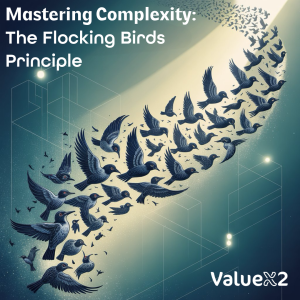Only 15% of leaders will be able to pass this new era if you don’t want to stay behind. Find out how to utilize AI agents and lead with impact!

There’s so much talk, hype, and noise in the market about AI agents that it’s becoming difficult to discern what’s real, what isn’t, and what it even is to begin with. You have the techno-optimists who believe this is the greatest thing since sliced bread, and the techno-pessimists who are certain we’re doomed.
The reality, for most business leaders, lies somewhere in between. In a recent live discussion, AI adviser Andreas Welch and New York Times bestselling author Dr. Evelyn Reed, both LinkedIn Learning instructors, cut through the noise to offer a pragmatic perspective on what leaders truly need to know about AI Agents. Here are the essential insights from their conversation, which highlight the importance of leadership development courses and leadership skills training in this new era.
What Exactly are AI Agents?
Before diving into strategy, it’s crucial to understand the fundamental shift that agentic AI represents. For decades, software was written with explicit if-then instructions. Then, machine learning allowed systems to recognize patterns in data and make recommendations.
Now, we are entering a new era. As Andreas Welch explains, “We’re at the point where we can already give a goal to a system.”
Instead of providing step-by-step instructions, you can give an AI agent a high-level objective, such as:
- “Plan the travel logistics for my upcoming team offsite in London, optimizing for cost and travel time.”
- “Develop a comprehensive marketing strategy, from defining the ideal customer profile to creating messaging and creative assets.”
The agent then autonomously breaks down the goal into sub-tasks, executes them, and presents the results for review. The key change is the agency—the ability to act on its own to achieve a goal. As Dr. Evelyn Reed adds, a critical component is that these agents can also learn. “If something changes in the environment… it’ll look at the past history and say, ‘I can interpolate and learn from this.'”
The Great Unsettling: Why the Old Playbook Fails

Remember when leadership meant having all the answers, a well-defined strategic map, and a clear path to execution? That era is rapidly receding into the rearview mirror. The traditional, top-down command-and-control model, effective in stable, predictable environments, is simply no match for the velocity and volatility of today’s market.
The biggest pain point that leaders face is being expected to “know-it-all.” Most leaders feel tremendous pressure to be the smartest guy in the room, to know everything in an encyclopedic way, and to have a solution for every issue. This places unrealistic weight on individuals and clogs innovation. As change increases speed, one leader simply cannot keep up with the immense amount of information and quick decision-making needed throughout convoluted systems.
The Solution: From Authority to Agility. The leadership need of the future is to shift from being the solitary source of solutions to becoming a catalyst for collective intelligence. As one leadership expert put it so presciently, “We are entering a space where we have to take people on a journey with us where the leader is not going to be the smartest person in the room, who’s not going to have the answers, and we accept that we don’t have the answers.”
This is not a relinquishment of control; it’s a raising of stature. As AI agents are expected to expand into a USD 47.1 billion market by 2030, independently managing tasks from email sorting to performance review, your task is completely different. You’re not the gatekeeper of information anymore; you’re the builder of a space where human excellence and AI productivity can not only coexist but actually work together and support each other.
Instead of: “Here’s what you specifically need to do in order to meet next quarter’s goals.” Attempt: “Here is the overarching challenge we’re confronting in the marketplace. What are your various viewpoints on how we could think innovatively about this with our human and AI strengths?”
Rather than: “I’ll do the thorough market analysis.” Try: “Our AI agent can run these huge data sets and find patterns, but I require your special human intuition about what these patterns imply for our customers and our future strategy.”
If you are enjoying this article, make sure you check out the Leading with Agility (ICP-LEA) Training Course with Certification.
How Should Leaders Leverage AI Agents?
While algorithms work on the logical, the repetitive, and the predictive, the need for what human beings alone can provide is soaring. These are your actual superpowers: empathy, intuition, adaptability, and the deep ability to make meaning.
1. Can AI Really Understand My Team’s Problems?
Data Without Discernment: AI can provide breathtakingly accurate data: 15% decrease in productivity, 10% increase in customer churn. But it won’t explain why. It won’t explain that Jennifer is dealing with the overwhelming burden of caring for a sick parent, that Mark is struggling with anxiety due to a looming reorganization, or that the whole team is stunned by the sudden loss of a much-loved manager.
The Solution: Where Empathetic Leadership is No Longer “Nice to Have,” but Business-Critical. This is where empathetic leadership is no longer “nice to have,” but business-critical. Where the human story, the hidden emotions, and the implicit difficulties beneath the numbers are understood, is where leaders create irreplaceable, tangible value. Your capacity to relate, to listen, and to really see your people is what builds resilience, loyalty, and enduring performance.
2. To Lead Others, Do You First Need to Understand Yourself?
To be able to lead others through non-stop change, you first have to know the terrain of your own internal world. The Johari Window is still a valuable resource for this self-revelation, which asks hard questions:
- What do I know about myself that everyone else can see too? (Your open area)Your public self, your surface-level strengths.
- What do I know about myself that others do not observe? (Your blind area)Your inner thoughts, vulnerabilities, and dreams.
- What do others observe about me that I’m not aware of? (Your blind spots: Those habits or qualities you project without realizing.
- What don’t I know about myself, and others also don’t observe? (Your unknown potential)Hidden strengths, undiscovered skills.
Practical Application: Take five minutes every morning to conduct a simple yet deep self-reflection: “Who am I today? Where am I really standing? Where do I really want to take myself and my team?” Most leaders are so busy with outer demands that they never get around to aligning their inner compass. This self-leadership is the foundation of agile leadership.
3. What Should You Do When an AI Agent or a Team Member Makes a Mistake?
The Blame Game That Kills Innovation: When something goes wrong in a changing environment—a misfired AI model, a stalled project, a failed new initiative- the automatic human reaction is typically to find blame: “Who did this?” This reflex, although habitual, is a powerful eroder of psychological safety, trust, and, by extension, innovation.
The Solution: Adopting a Systems Mindset As W. Edwards Deming famously put it, “95% of an individual’s performance comes from the system they work within, not the individual themselves.” When something goes wrong, your initial response should be curiosity, not accusation. Each time you say “Who did this?” rather than “How did this occur within our system?”, you’re putting up barriers to learning and creating a culture of fear.
The Curiosity Questions That Turn Everything Around:
- “What was going on in our system, our process, or our environment that led to this result?”
- “What key information were we lacking or misunderstanding that might have averted this?”
- “How can we refine our combined process to increase the chances of success next time?”
- “What valuable lessons can we take away from this experience that will enable us to improve and adjust quicker?”
This transition is more difficult than it appears, requiring effortful awareness to overcome deep-seated reactive habits. But it is essential for developing an agile, resilient organization.
Check this blog to master Agile Transformation: Key Steps and Challenges
4. If AI Agents Handle the Data, What’s Left for You to Do?
The Disappearance of Meaning in Data Glut: With a world of constant data streams and machine reports, teams can easily get lost in the “why.” Numbers can tell, but not often inspire. Artificial intelligence can empathize, mimic emotions, and even anticipate human reactions, but it can’t create a vivid picture of the future that inspires you to lead others into the unknown.
The Solution: Writing the Story That Engages Hearts and Minds. Humans are storytelling animals. From myth to movie, narrative is how we understand the world, find meaning, and connect to purpose. Your job as a leader is to write the story that tells not only what your team or organization is doing, but why it matters most. Your AI agent supplies the information; you supply the meaning.
Your Leadership Story Framework: All great leadership stories require three essential elements:
The Challenge: What major problem are we addressing? Why is it pressing, significant, and pertinent to our stakeholders?
The Journey: What ambitious actions will it require to get there? What challenges will we necessarily encounter, and what resources (human and technical) will we use?
The Vision: What does success really look like? How will the world, our customers, our co-workers, or our community be measurably different and better as a result of what we do?
Your AI agent can assist you in compiling factual information for each component, but the story itself, the emotional progression, the evocative words, and the encouraging link- that’s human work.
Mastering: The Flocking Birds Principle

Micromanagement in a Dynamic Environment.
Control has traditionally been equated with success, creating micromanagement. But in today’s complex adaptive systems, such as organizations facing perpetual change, over-control snuffs out exactly the agility and emergent intelligence necessary to succeed.
The Solution: Facilitating Emergent Behavior through a Simple Rule. Organizations are like flocks of birds: they act according to simple rules in a way that produces intelligent, emergent behavior. The leadership insight is that optimization is not about controlling everything; it’s about setting the right conditions for intelligent behavior to emerge naturally.
Researchers observing flocks of birds discovered they could not forecast behavior using complicated algorithms, but could replicate it with three simple rules:
- Go in the same direction as others.
- Be close, but not too close.
- Don’t bump into each other.
For leaders, this becomes a dynamic, responsive principle:
Align on direction: Make sure everyone profoundly gets the fundamental mission, values, and key priorities. This gives the mutual “compass bearing.”
Establish psychological safety: Build a culture where individuals feel comfortable enough to work closely together, exchange ideas, and offer criticism without fear of reprisal. It is the “stay close, but not too close.”
Cut down barriers: Your main work is in clearing the path for your teams, removing bureaucratic obstacles, and enabling them to self-organize and fix problems themselves. It is the “avoid collisions.”
Know more about Business Agility: What is it and Why is it Important?
What Skills Do You Need to Stay Effective in the AI Era?
1. The Mindfulness Imperative: Leading from the Inside Out.
All of the 2025 emotional intelligence trends- self-perception, self-expression, interpersonal skills, decision-making, and stress management- depend on one key practice: mindfulness. Not old-school meditation, but making a conscious effort to take time to pause and look within. Five minutes every day can have a profound impact:
- “Where am I doing right in this project?”
- “What am I feeling, and why?”
- “What does my team really need from me today?”
- “How can I come at this with curiosity rather than judgment?”
This exercise resonates with the idea of ikigai, locating where you find meaning at the intersection of what you love, what you are great at, what the world needs, and what you can get paid for. In an AI-advanced world, your ikigai increasingly leads towards your uniquely human strength and contribution.
2. The Benefit Mindset: More than Growth to Impact
We know the fixed vs. growth mindset, but there is a critical third level coming into view for leaders: the benefit mindset.
- Growth mindset is: “How can I learn and get better?”
- Benefit mindset is: “How can my improvement and our combined effort bring concrete value to others and the world?”
Your AI agent can optimize processes and forecast outcomes better than anything. But it cannot truly care about the larger effect of your organization’s efforts on society, the planet, or the daily lives of your employees and customers. This “caring” is a human-only ability that generates greater purpose and enduring effect.
3. The Conversation Routine: From Status Updates to Collaboration
Drain-Without-Return Meetings: A pitfall of organizations adopting new technology is subjecting human interactions to machine-like treatment. Stand-ups, for instance, readily degenerate into routine status updates to managers instead of dynamic, collaborative brainstorming sessions.
The Solution: Human Connection and Insight. First, your AI agent can send a complete status report in seconds. What you need from humans are conversations that:
- Enable possibilities exploration and generate innovative solutions.
- Reveal hidden roadblocks and shared blind spots.
- Establish an authentic connection and promote psychological safety.
- Create new insights via diverse views.
- Build alignment and shared commitment.
Before your next meeting, ask yourself: “Is this agenda something an AI agent could efficiently handle, or does it genuinely require human insight, creative ideation, and empathetic connection?” Turn your focus to the latter.
Your Leadership Action Plan: Thriving in Constant Flux
The dilemma and possibility in this ever-evolving world are not abstract; they exist. Those leaders who will succeed must actively cultivate a new range of human skills that place emotional intelligence, adaptable thinking, and human-oriented leadership at their core.
Below is how to start your transformation, not only for AI, but for any wave that is coming on the horizon:
This Week: Calibrate Your Inner Compass
Practice the Pause: Take a deliberate breath before responding to a problem with “Who did this?” instead. Ask, “What in our system led to this result?”
Hold Space for Uncertainty: In one meeting or more, recognize a moment of “I don’t know,” then actually ask for others’ varied views and insights.
Check Your Emotional Temperature: Place three random alarms on your phone over the course of the day. When they ring, stop, pay attention to what you are feeling, and think about where it came from.
Make sure to check out- Leading SAFe® – Meaning, Benefits, SAFe® Certification Process & More!
This Month: Grow Your Awareness and Story
Map Your Johari Window: Seek three honest, constructive appraisals from trusted colleagues or mentors regarding your blind spots and how you’re viewed.
Craft Your Leadership Story: Write a persuasive, one-page story that captures your team’s or organization’s challenge now, the path forward, and the inspiring vision of achievement.
Experiment with Simple Rules: Identify one place where you micromanage or over-control. Instead, attempt to define no more than three simple, governing rules or principles and trust your team to self-organize under them.
This Quarter: Deepen Your Practice and Systems Thinking
Develop Your Mindfulness Practice: Pledge five minutes of daily, focused reflection. This might be easy breathing, journaling, or a peaceful minute of inner check-in.
Develop Your Team’s Human Skills: Provide committed space and opportunity for building creativity, empathy, active listening, and joint problem-solving, in addition to any AI tool training.
Practice Systems Thinking: When facing a complex challenge, resist the urge to jump to immediate solutions. Instead, take time to map out all the interconnected elements, potential ripple effects, and feedback loops before deciding on a course of action.
Ready to Develop Your Leadership for the AI Age?
The challenges and opportunities outlined in this post may seem unreal, but they’re happening right now in organizations around the world. Leaders who want to thrive alongside AI agents need to develop a new set of capabilities that emphasize emotional intelligence, adaptive thinking, and human-centered leadership alongside of all this, they don’t need solutions they need a mindset to work with problems like these, because things will keep moving very rapidly in this direction, and all you need is agility to take over the leadership role.
That’s exactly what ValueX2’s ICP-LEA (Leading with Agility) certification is designed to address. This ICAgile-accredited program goes beyond traditional leadership training because this training helps you get an agile mindset, which you need to uncover the modern truths about this changing world. It provides you with practical frameworks and deep personal development opportunities to help you lead with agility, empathy, and impact. Moreover, this training has proven its value and has a very good track record amongst leaders and aspiring leaders; everyone has seen good results. If you want a full guide on how it can enhance your career opportunities, drop a comment, and we’ll make it happen!
Frequently Asked Questions (FAQ) on Agile Leadership
Q1: There is a lot of chatter now regarding agile leadership programs. Why?
A1: We see a quick turnaround in competition, demand, technology, and customer expectations. This calls for organizations to respond and adjust rapidly to live and survive. Most organizations are shifting away from traditional industrial-era models of leadership to agile models more appropriate for the digital age, where agile leaders need to drive innovation, collaboration, and value creation at unprecedented scale and speed. The pandemic further hastened this shift. This has led to an increase in demand for leadership courses and leadership development programs.
Q2: Are conventional leadership qualities still applicable in an AI-powered agile environment?
A2: Yes, classic behaviors such as leading by example, moral values, and employing power to persuade are still applicable in certain situations. Nevertheless, the classic style of leading will not work for agile organizations. Leaders must cultivate new mindsets and skill sets to face the 21st century. In an agile environment, leaders exert more influence than direct power; they are coaches and developers of individuals, and also, outstanding listeners and communicators. Many leadership training programs now focus on these agile leadership skills.
Q3: What are some core practices or competencies for agile leaders?
A3: Agile leaders excel at regulating their own emotions and those of others for organizational effectiveness. They are ready to shift strategies to exploit new opportunities or address unforeseen challenges. These include being a great communicator, a great storyteller, encouraging psychological safety, understanding complexity, making quick decisions despite insufficient information, coaching and building high-performing teams, and learning constantly themselves in order to create a learning organization. These competencies are often the focus of leadership skills training and leadership development courses.
Q4: Is it possible for anyone to be an agile leader?
A4: Yes, anybody can be an agile leader. It is just a matter of your belief and making a conscious effort to develop the required capabilities and skills. Conscious effort leads to success, albeit a bit down the road. Many online leadership development programs and leadership certifications online are available to help individuals develop these skills.
Q5: How is “self-leadership” connected to leading with agility?
A5: Leading with agility really begins with self-leadership. It means knowing your own beliefs, values, thoughts, and feelings, and then behaving and acting accordingly. Psychological safety within an organization also starts with the individual.
Q6: What is “business agility,” and how is it related to leading with agility?
A6: Business agility is a mode of operating that covers the whole functioning of an organization, culture, mindset, and structure of an entire company across all functions, such as marketing, sales, finance, and IT. Leading with agility involves adopting and comprehending business agility principles such as psychological safety and customer focus.
Q7: How is the term “anti-fragility” defined in leadership terms?
A7: Anti-fragility refers to how organizations and individuals are strengthened and prosper through exposure to volatility, uncertainty, complexity, and ambiguity (VUCA). For leaders, this would involve being ready to have current knowledge diminish when it is no longer considered valuable, being adaptable enough to switch between new skills without being crushed by pressure. This is in contrast with a “fear-based culture” that is resistant to change and does not encourage questions. Developing anti-fragility is often a key component of leadership development courses.
Q8: What is the “benefit mindset,” and why should leaders care about it?
A8: The benefit mindset goes beyond personal development (“How can I learn and get better?”) to ask, “How can my development add value to others and the world?”. In a world powered by AI, leaders who prioritize a benefit-oriented mindset contribute something that’s not replaceable – they keep the bigger societal and environmental goal in mind for the work that their organizations do, and the well-being of their customers and employees.

Bhavna is an Agile Coach and Consultant with 15+ years of experience in advisory, corporate finance, IT assurance, and operations at Big 4 and within the industry in the UK and India. She has recently been the CEO of a start-up where she implemented agile practices within HR, Marketing, and Product teams.
She is also a SAFe® Practice Consultant (SPC) and authorized instructor for ICAgile Agility in HR (ICP-AHR), Agility in Marketing (ICP-MKG), and Business Agility Foundations (ICP – BAF) training courses. She provides training for agile transformation to corporate, public, and private batches, as well as consulting for enterprise agile transformation.






